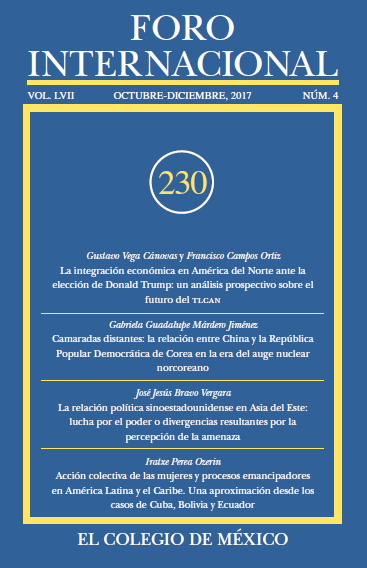The Sino-US political Relationship in East Asia: Struggle for Power or Differences Arising from Perception of the Threat
DOI:
https://doi.org/10.24201/fi.v52i4.2472Keywords:
Structural realism, neoclassical realism, constructivism, identity, perception of the threatAbstract
Rather than a direct power struggle, the current Sino-US political relationship in East Asia reveals complex interaction based on their respective identities. As the hegemonic power, the United States needs to maintain the credibility of its power and act accordingly, while the People’s Republic of China acts not only as an ascendant power that is demanding a sphere of regional recognition, but also with an interest in reestablishing its territorial integrity. This paper presents brief interpretations of the bilateral relationship from the perspective of structural realism and neoclassical realism, as well as that of constructivism, not without emphasizing the perception of the threat as the element explaining the current differences between the two countries
Downloads
References
Abidol, Aldo D., “Causes of the 1962 Sino-Indian War”, Josef Korbel Journal of Advanced International Studies, vol. 1, 2009, pp. 74-88.
“Acuerdo de Asociación Transpacífico (TPP) - Australia, Brunei Darussalam, Canadá, Chile, Estados Unidos, Japón, Malasia, México, Nueva Zelandia, Perú, Singapur y Viet Nam”, Sistema de Información de Comercio Exterior, en www.sice.oas.org/TPD/TPP/TPP_s.ASP
Adler, Emmanuel, “Seizing The Middle Ground Constructivism in World Politics”, European Journal of International Relations, vol. 3, núm. 3, 1997, pp. 319-363.
Anguiano, Eugenio, “Seguridad regional en Asia Pacífico”, Anuario Asia Pacífico, núm. 4, 1997, pp. 27-69.
______ , “Diplomacia de la República Popular China”, en E. Anguiano (coord.), China contemporánea. La construcción de un país (desde 1949), México, El Colegio de México, 2001, pp. 179-284.
Arroyo Velasco, Rosario y Graciela Pérez Gavilán, “El conflicto chino-tibe-tano desde la perspectiva de la ética en Relaciones Internacionales”, Revista de Relaciones Internacionales de la unam, núm. 91, 2003, pp. 57-67.
Bravo Vergara, José J. y Miguel A. Sigala Gómez, “Constructivismo”, en Jorge Alberto Schiavon Uriegas, Adriana Sletza Ortega Ramírez, Marcela López-Vallejo Olvera y Rafael Velázquez (eds.), Teorías de Relaciones Internacionales en el siglo XXI. Interpretaciones críticas desde México, México, Benemérita Universidad Autónoma de Puebla-El Colegio de San Luis-Universidad Autónoma de Baja California-Universidad Autónoma de Nuevo León-Universidad Popular Autónoma del Estado de Puebla, 2014, pp. 435-453.
Brooks, Kenneth y William Wohlforth, World Out of Balance: International Relations and the Challenge of American Primacy, Princenton, University Press, 2008.
Brooks, Stephen G. y William Wohlforth, “American Primacy in Perspec-tive”, Foreign Affairs, vol. 81, núm. 4, 2002, pp. 20-33.
______ y William Wolhforth, World Out of Balance: International Relations and the Challenge of American Primacy, Princenton, University Press, 2008.
Bukovansky, Mlada, “American Identity and Neutral Rights from Independence to the War of 1812”, International Organization, vol. 51, núm. 2, 1997, pp. 209-243.
Chang, Gordon G., “Economic Implications of Provocative Chinese Behavior in the East China Sea”, en Richard Pearson (ed.), East China Sea Tensions: Perspectives and Implications, Washington, DC, The Maureen and Mike Mansfield Foundation, 2014, pp. 15-22.
Declaración conjunta de China y Rusia sobre el Orden Internacional en el siglo XXI, 2 de julio de 2005, en www.mfa.gov.cn/esp/zt/hjt-fwelssk/t202164.htm
Erickson, Andrew S., “Keeping the Near Seas Peaceful: American and Allies Mission, Asia-Pacific Interest”, en Richard Pearson (ed.), East China Sea Tensions: Perspectives and Implications, Washington, DC, The Maureen and Mike Mansfield Foundation, 2014, pp. 23-30.
Ferreira, Rui, “EEUU envía infantes de marina a Australia ante el aumento del poderío chino”, El Mundo, 17 de noviembre de 2011, en www.elmundo.es/america/2011/11/17/estados_unidos/1321564323.html
Foong Khong, Yuen, “Primacy or World Order?: The United States and China’s Rise”, International Security, vol. 38, núm. 3, 2013-14, pp. 153-175.
Forigua-Rojas, Emersson, “Guerra en Afganistán: la experiencia soviética”, Papel Político, vol. 15, núm. 1, 2010, pp. 183-234.
Friedberg, Aaron L., A Contest for Supremacy: China, America, and the Struggle for Mastery in Asia, Nueva York, W. W. Norton & Company, 2011.
_____, “The Sources of Chinese Conduct: Explaining Beijing’s Assertiveness”, The Washington Quarterly, vol. 3, núm. 4, 2015, pp. 133-150.
Gaddis, John Lewis, Nueva Historia de la Guerra Fría, México, Fondo de Cultura Económica, 2011.
Garret, Banning, “US-China Relations in the Era of globalization and Terror: A framework for analysis”, Journal of Contemporary China, vol. 15, núm. 48, 2006, pp. 389-415.
Gelman, Harry, “The Soviet Far East Buildup and Soviet Risk-Taking Against China”, A project AIR FORCE report prepared for the United States Air Force, The Rand Corporation, R-2943-AF, agosto de 1982.
Gerson, Michael S., “The Sino-Soviet Border Conflict: Deterrence, Escalation, and the Threat of Nuclear War in 1969, Defense Threat Reduc-tion Agency Advanced Systems and Concepts Office”,Report Number ASCO, 2010 027, Contract Number NOOO14-05-D-0500, 2010.
Hinton, Harold C., La China comunista en la política mundial, trad. de Ramón F. Martel, México, Unión Tipográfica Editorial Hispano Americana, 1968.
Holsti, Kal J., “Exceptionalism in America Foreign policy: Is it exceptio-nal?”, European Journal of International Relations, vol. 17, núm. 3, 2011, pp. 381-401.
Hopf, Ted, “The Promise of Constructivism in International Relations Theory”, International Security, vol. 23, 1998, pp. 171-200.
Huang, Jing y Xiaoting Li, “China’s Taiwan Policy: Dilemma and Choice”, Pacific Focus, vol. 16, núm. 2, 2001, pp. 99-114.
Jian, Chen, China’s Road to the Korean War: The Making of the Sino-American Confrontation, Nueva York, Columbia University Press, 1994.
______, China en transición. Sociedad, cultura y economía, Barcelona, Bellaterra, 2000.
Johnson, Paul, Estados Unidos: la historia, Buenos Aires, Javier Vergara Editor, 2002.
Johnston, Alastair I., “Cultural Realism and Strategy in Maoist China”, en Peter Katzenstein, The Culture of National Security: Norms and Identity in World Politics, Nueva York, Columbia University Press, 1996.
Kagan, Robert, The Return of History and the End of Dreams, Nueva York, Alfred Knopf Editors, 2008.
Kang, David, China Rising: Peace, Power, and Order in East Asia, Nueva York, Columbia University Press, 2007.
Kissinger, Henry, “Obama’s Foreign Policy Challenge”, Washington Post, 22 de abril de 2009.
Lebow, Richard Ned, “Identity and International Relations”, International Relations, vol. 22, núm. 4, 2008, pp. 473-492.
Li, Rex, “North East Asia”, enMary Buckley y Robert Sing (eds.), The Bush Doctrine and the War, Terrorism: Global responses, Global consequences, Nueva York, Routdlege, 2006.
Lieber, Robert, The American Era Power and Strategy for the 21st Century, Cambridge, University Press, 2005.
Ling, L. H. M., “Worlds beyond Westphalia: Daoist dialectics and the «China Threat»”, Review of International Studies, núm. 39, 2013, pp. 549-568.
Lipset, Saymour Martin, El excepcionalismo americano: una espada de dos filos, México, Fondo de Cultura Económica, 2000.
Mann, James, A History of America’s Curious Relationships with China, from Nixon to Clinton, Nueva York, Vintage Books, 1998.
Morgenthau, Hans J., Politics Among Nations: The Struggle for Power and Peace, Nueva York, A. A. Knopf, 1948.
Morrison, Wayne M., “China-U.S. Trade Issues”, Congressional Research Service, CRS Report prepared for Members and Committees of Congress, 7.5700, RL33536, 24 de abril de 2017, en https://fas.org/sgp/crs/row/RL33536.pdf
Nathan Andrew J. y Andrew Scobell, “How China Sees America”, Foreign Affairs, septiembre-octubre de 2012, pp. 32-47.
National Security Strategy, mayo de 2010, en http://nssarchive.us/NSSR/ 2010.pdf
National Security Strategy, febrero de 2015, en http://nssarchive.us/wp-content/uploads/2015/02/2015.pdf
“Obama apoya a Japón en disputa territorial con China por islas Senkaku/Diaoyu”, BBC Mundo, 23 de abril de 2014, en http://www.bbc.com/mundo/ultimas_noticias/2014/04/140423_ultnot_eeuu_obama_apoyo_senkaku_tsb
Oest, Kajsa Ji Noe y Peter Toft, “The Shanghai Cooperation Organization-A Threat or Opportunity for Europe?”, Institut for Statskundskab, 2007.
Ou, Chen, “The U.S.’ Political Challenges on China’s National Security in the 21st Century’s First Decade”, Asian Social Sciense, vol. 7, núm. 6, 2011, pp. 103-109.
Podliska, Bradley, Acting Alone: A Scientific Study of American Hegemony and Unilateral Use-of-Force Decision Maker, Lanham, MD, Lexigton Books, 2010.
Powers, John, History as Propaganda: Tibetian Exiles Versus the People’s Republic Of China, Nueva York, Oxford University Press, 2004.
Prozumenschikov, Mikhail Y., “The Sino-Indian Conflict, the Cuban Missile Crisis, and the Sino-Soviet Split, October 1962: New Evidence from the Russian Archives”, Cold War International History Project Bulletin, 1996-1997, pp. 251-257.
Rudd, Kevin, “The Future of U.S.-China Relations under XI Jinping: Toward a New Framework of Constructive Realism for a Common Purpose”, Asia Society Policy Institute, en http://asiasociety.org/po-licy-institute/us-china-21-future-us-china-relations-under-xi-jinping
Ruggie, John Gerard, Constructing the World Polity: Essays on International institutionalization, Londres-Nueva York, Routledge, 1998.
“Rusia y China vetan la resolución de condena a la represión siria”, El Mundo, 5 de octubre de 2011.
Santa Cruz, Arturo, Un debate teórico empíricamente ilustrado: la construcción de la soberanía japonesa, 1853-1902, Guadalajara, Universidad, 2000.
“Second Taiwan Strait Crisis Quemoy and Matsui Islands”, en http://www.globalsecurity.org/military/ops/quemoy_matsu-2.htm
Shih, Chih-yu y Chiung-chiu Huang, “China’s Quest for Grand Strategy: Power, National Interest, or Relational Security?”, The Chinese Journal of International Politics, vol. 1, núm. 26, 2014, pp. 1-26.
Shin, Hee-Suk, “U.S.-Japan Security Relations and the Politics of Northeast Asia”, Asian Perspective,vol. 20, núm. 2, 1996, pp. 333-341.
Solomon, Chris, “Does China’s Silk Road lead to Damascus?”, Global Risk Insights, 5 de julio de 2016, en http://globalriskinsights.com/
Soto, Augusto, “China ante la crisis iraní”, Real Instituto Elcano, área Asia Pacífico, ARI núm. 49-2006.
“Taiwan Strait I: What’s Left of «One China»”, ICG Asia Report No 53, Beijing/Taipei/Washington/Brussels International Crisis Group, 6 de junio de 2003.
Waltz, Kenneth, Teoría de la política internacional, trad. de Mirta Rosenberg, Buenos Aires, Grupo Editor Latinoamericano, 1988.
______, “Structural Realism after Cold War”, International Security, vol. 25, núm. 1, 2000, pp. 5-41.
Welch Larson, Debora y Alexei Shevchenko, “Status Seekers: Chinese and Russian Responses to U.S. Primacy”, International Security, vol. 34, núm. 4, 2010, pp. 63-95.
Weldes, Jutta, “Constructing National Interest”, European Journal of International Relations, vol. 2, núm. 3, 1996, pp. 275-318.
Wendt, Alexander, “Anarchy is what States Make of it: The Social Construction of Power Politics”, International Organizations, vol. 46, núm. 2, 1992, pp. 391-425.
Wie-cheng Wang, Vincent, “Bill Clinton’s «Three Noes» and Taiwan’s Future”, en Winston L. Yang y Deborah A. Brown (eds.), Across the Taiwan Strait: Exchanges, Conflicts and Negotiations, Jamaica, NY, Center of Asian Studies, St. John’s University, 1999, pp. 253-303.
Wohlforth, William, “The Stability of Unipolar World”, International Security, vol. 24, núm. 1, 1999, pp. 5-41.
_____, “Unipolarity, Status, and Great Power”, World Politics, núm. 61, 2009, pp. 28-57.
Xinbo, Wu, “Forging Sino-US Partnership in the Twenty-First Century: Oportunities and challenges”, Journal of Contemporary China, vol. 12, núm. 75, 2012, pp. 391-407.
______, “Agenda for a new Great Power Relationship”, The Washington Quarterly, vol. 37, núm. 1, 2014, pp. 65-78.
Yuan, Jing-dong, “Sino-Russian Confidence building Measures: A Preliminary Analysis”, Working Paper No 20, enero de 1998, pp. 1-20.













